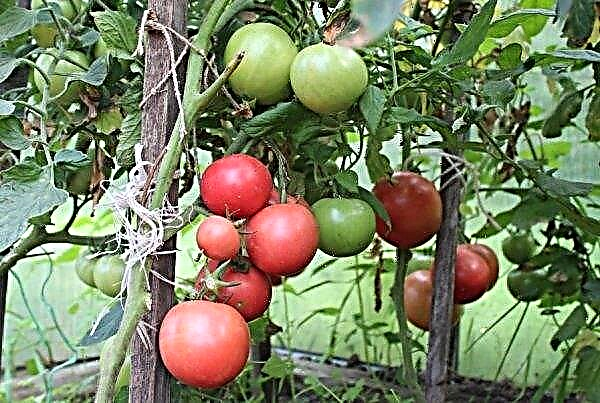A small greenhouse can be built from any material - plastic, polycarbonate, wood, metal. In small farms, improvised materials, for example, window frames, can be used for this. Read about how to make a greenhouse out of old window frames in this article.
Did you know? Greenhouses do not need constant sunlight during the day. The morning sun and afternoon shading are optimal conditions for most plants. By planting trees on the southwestern side of the structure, you get a natural cooling mechanism on a hot afternoon.
Pros and cons of using window frames to create a greenhouse
If after replacing old wooden frames with plastic euro-windows you still have old, but high-quality structures, do not rush to throw them away. They can be useful as material for a small greenhouse.
- The main advantages of such a building:
- free material for the frame;
- in the presence of window leaves - the organization of good ventilation of the greenhouse;
- high installation speed - all old windows are the same, and you can assemble the structure in a couple of hours;
- ease of assembly - you will need a small amount of tools and supplies.
Such a greenhouse can be not only easily assembled, but also quickly disassembled and moved to another place. In addition, the frames give the building a non-standard appearance. And this can be a great find for landscaping on the site.
- Design disadvantages:
- the size of the frame creates a fixed size of the building, in order to change something, you need a cut;
- old windows may not be enough for a full-fledged greenhouse and you will need to supplement them with other materials, which affects the appearance of the structure;
- the roof of the greenhouse must be made of another material, such as polycarbonate, so that it is more resistant to adverse weather.
How to make a greenhouse from window frames with your own hands
First of all, decide what size greenhouse or greenhouse you will need, calculate the number of required building materials. Pick up a site for construction and prepare tools.
General requirements for a greenhouse:
- Stationary structures must be placed in the east-west direction. This allows you to get maximum lighting in the autumn-winter period. For greenhouses that will be used only in the spring, this is not so important.
- External air blowing has a significant effect on the temperature inside the structure. To obtain the highest possible temperature, install greenhouses in places protected from the wind.
- The greenhouse from the frames can be single-pitched or gable. Sheds are often installed if the structure is supported by one of the load-bearing walls of the building.
- The roof of the structure can be provided from polycarbonate. This polymer material, which perfectly transmits light, is 12 times lighter than glass and 50 times stronger. It is resistant to aggressive environments.
Important! Use large frames for walls, and for the roof, those that will be smaller. This is due to the fact that the roof is exposed to rain and must be more durable.
Calculation of the required amount of material and tools
First of all, start by preparing materials and tools. The main material is wooden frames removed during the installation of plastic windows. They are sure to remove accessories, clean off old paint. The wood is cleaned from bumps with a grinder and treated with an antiseptic in order to prevent rotting processes. Before you begin, you must ensure that the wood is in good condition.
All actions are performed only with dry and clean workpieces. Wet - must be dried. At the processing stage, it is recommended to remove the glass so as not to damage them. Perform the necessary calculations - measure the frames and specify how large the greenhouse will be. When calculating, remember that the recommended distance between individual plants or between rows is indicated as 0.3-0.6 m, depending on the type of plant. You will also need to provide a passage between the beds to care for vegetables. Do not forget that on one side of the structure you need to make a door, and on the other, you will need a hole for installing a fan (optional). In order for the greenhouse to turn out without gaps, all the elements must be adjusted to each other. You can blow out small gaps with foam.
You will also need to provide a passage between the beds to care for vegetables. Do not forget that on one side of the structure you need to make a door, and on the other, you will need a hole for installing a fan (optional). In order for the greenhouse to turn out without gaps, all the elements must be adjusted to each other. You can blow out small gaps with foam.
Tools required for work:
- sawing wood for cutting wood materials;
- screwdriver for fastenings;
- yardstick;
- construction cord, pegs for marking the foundation;
- hammer;
- nails and screws;
- sealant, paint, building glue.
Basic materials for construction:
- timber for the frame of the greenhouse;
- prepared wooden frames;
- material for the roof (polycarbonate, film).
Important! Concrete dries for at least 2 weeks, so after pouring the foundation, it will take time until it completely hardens.
Seat selection
A greenhouse made of glazed wooden window frames will be sensitive to temperature changes, so the site should be covered from the wind by trees or buildings. Do not install in lowlands where damp or groundwater accumulates. This will reduce the useful life of the structure. Trees should not block the sun from entering the greenhouse. Allowed the possibility of "spotted" light when direct sunlight falls on the structure for several hours a day.
Preparation and cleaning of the territory
Preparation of the territory for construction consists in the removal of weeds and preliminary marking of the site. It is carried out using pegs, a construction cord and a shovel.
Making the foundation for the greenhouse
The easiest way to prepare the site for the installation of the structure is to create a sand and gravel pillow on which the greenhouse will stand.
For this:
- Dig a recess with a depth of about 20 cm.
- Gravel is poured to the bottom (2/3 of the volume), and then a layer of sand. Tightly compacted, and then pour a layer of soil on top. Sand and gravel will prevent the contact of wooden frames with soil moisture.
If you are preparing a full-fledged foundation, you will need to dig holes for pipes on which the frame of the greenhouse will be mounted and pour the same sand-gravel mixture into the pit, which was discussed above. The thickness of the gravel pillow is 20 cm. The depth of the pit may be greater, it depends on the level of soil freezing in winter.
Fittings are installed in the pipes and concrete is poured. When it cools down, the frame of the greenhouse is mounted on the reinforcement. The grounding depth of the pipes is 1 m. Make a distance between them of about 0.7 m or accept an adjustment for the frame dimensions. Foundation pipes should be 0.2 m higher than gravel, and reinforcement 0.25 m.
We assemble the frame of the greenhouse from window frames
The basis for the walls is the frame. To create it, supporting beams will be required.
Frame construction sequence:
- Corner posts are installed on the reinforcement of the support posts. Then install racks along the walls. To put them on the fittings, they drill holes-grooves.
- Waterproofing is laid on concrete poles.
- The beam is fastened with self-tapping screws.
- The lower and upper bindings are attached to the racks.
- They assemble walls from window frames by attaching them to racks.
Did you know? The first greenhouses were used in ancient Rome. Gardeners covered the bed with cucumbers with thin plates of mica or cloth, thereby creating a greenhouse effect for them.
Check the alignment of the frame from all sides. Add or remove soil to level either side. If the area allows you, then you can assemble each wall separately, fastening the elements with screws on a flat surface. Make sure that the structure is absolutely even, and only then attach it to the racks. Check the alignment of the wall with a plumb line. Once the two side walls are built and nailed, assemble and lift the back (not door) wall into place and nail it to the foundation.
Flooring and the formation of beds in the greenhouse
In our description, the floor is created by a sand and gravel pillow, the thickness of which is about 20 cm. A layer of fertile soil is poured on top of the pillow. You can limit yourself to this and place plants directly in this soil. But in gardening, beds raised above the soil level are also widespread. The design is formed in the form of a kind of frame made of edged boards, into which the soil for the beds is filled.
This will be a good solution, since the “high bed” will have improved drainage and soil structure, and you will be able to form a soil mixture on the bed with layers of soil and organic matter that are needed for growing potatoes or melons. A track lined with gravel or tile between your beds will look good. This is not only aesthetically pleasing, but also inhibits weed growth.
Collect the roof
The technology for assembling the roof depends on what it will be assembled from. If these are the same frames, only smaller or polycarbonate, then:
- The rafters are attached to the upper harness with self-tapping rafters so that frames can be attached to them. The angle of inclination for a gable roof can be from 5 to 60 °.
- Screw the frames. Or cut polycarbonate in the right size and screw it to the rafters instead of frames.

Installation of doors and windows
The door is assembled with one of the sections of the greenhouse. You will need to collect the loot in which the door will be installed. Attach the frames next to it and put the wall in place. Loops are fastened in a loot and a door is put on them. If the windows were already framed, then nothing needs to be done. And if they were not there, then several frames are mounted in the same way as the door - on hinges, so that the greenhouse can be ventilated.
Ground greenhouses from old window frames
Ground greenhouse from old window frames can be made in the form of a cube or parallelepiped with a roof. Based on a high bed. Wall heights —0.3 m or higher. To create a greenhouse effect, the bed is covered with frames that are attached to one of its sides on hinges. Compact greenhouses or hotbeds heat up and cool faster than larger structures. Choosing a larger greenhouse creates more space for growing plants, and also allows you to stabilize the air temperature during spring temperature drops. Thanks to this, you can get the crop 1-2 weeks earlier than in the open ground.
Compact greenhouses or hotbeds heat up and cool faster than larger structures. Choosing a larger greenhouse creates more space for growing plants, and also allows you to stabilize the air temperature during spring temperature drops. Thanks to this, you can get the crop 1-2 weeks earlier than in the open ground.
You can choose any type of greenhouse and create one large greenhouse or several small ones. They will certainly accelerate the ripening of vegetables, so before you throw away the old, old windows, think about it, suddenly they will find application in your farm, or offer them to neighbors who are engaged in vegetable growing.












